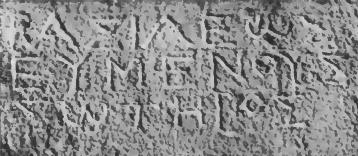This altar is decorated with a rosette surrounded by two bucranes and presents an inscription of good quality but with the uncommon detail of a cursive shape of omega, which may be interpreted as the influence of cursive writing on a private dedication. The stone was found in the neighbourhood of Gurnellia, situated south-east of the hill of Pergamon, in an area which was not yet urbanized in the second century, so that the original location of the altar remains unknown. The chronological limits of the dedication are provided by the use of the epithet Soter (mid-180s) and by the death of Eumenes II (159/8), after which the king was referred to with the denomination Theos.
Permanent ID
http://s.phrc.it/phrc027Images:
Photo 1: Squeeze of the inscription, from MDAI(A) 27 (1902), p. 95
Photo 2: Map of Bergama AvP I - Taf. II (1904) with the location of the Church of Agios Georgios in yellow; many thanks to Dr. Seçil Tezer Altay of DAI-Pergamon for sharing her knowledge of modern Bergama






